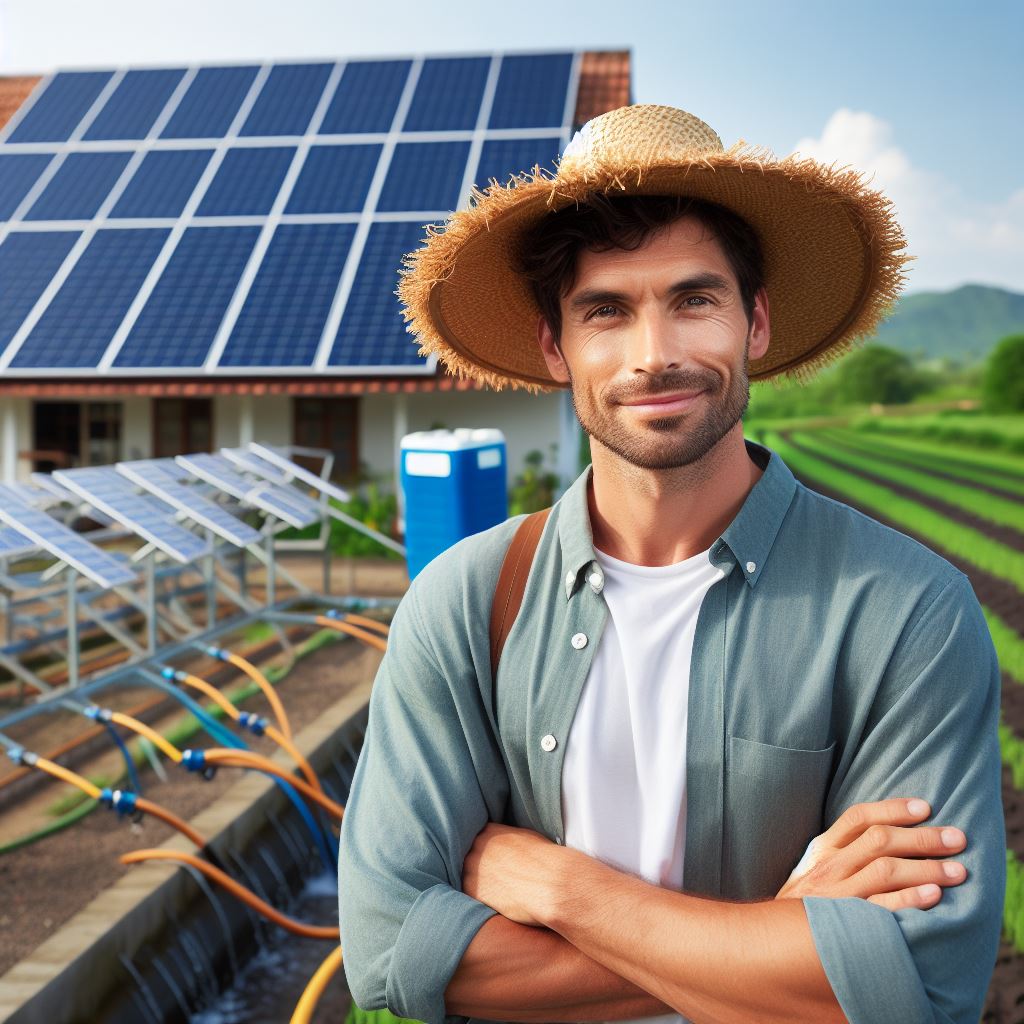Introduction
Solar energy is a renewable energy source that involves capturing and utilizing the sun’s energy to generate electricity or heat.
In recent years, it has gained significant importance in agriculture due to its numerous benefits.
Solar energy is considered environmentally friendly as it doesn’t emit greenhouse gases or air pollutants during its operation.
Additionally, solar energy is abundant and available in almost every region, making it a reliable and accessible source of power for agricultural activities.
The adoption of solar energy in agriculture has changed the way farmers operate, leading to increased efficiency and reduced costs.
Farmers can utilize solar panels to power irrigation systems, pumping water from wells or rivers to irrigate fields.
This eliminates the need for traditional diesel or electric pumps, reducing reliance on fossil fuels and lowering operating expenses.
Solar-powered irrigation systems also provide a more precise control of water distribution, ensuring optimal usage and preventing over-watering.
Solar energy is also transforming the use of machinery in agriculture.
Solar-powered equipment, such as tractors and harvesters, reduce dependence on fossil fuels and provide a greener alternative.
These machines leverage solar power to operate efficiently, resulting in reduced carbon emissions and lower operational costs for farmers.
Moreover, solar energy plays a significant role in optimizing crop growth. Farmers can install solar panels to generate electricity that is used for lighting in greenhouses, extending the growing season and increasing crop yields.
Solar energy-powered sensors and monitoring systems enable farmers to collect data on soil moisture, temperature, and other environmental factors, allowing for precise decision-making and customized crop management.
In short, solar energy is revolutionizing agriculture by providing a sustainable and clean energy solution.
Its usage in irrigation systems, machinery, and crop optimization is transforming the agricultural sector, improving efficiency, and reducing environmental impact.
Transform Your Agribusiness
Unlock your farm's potential with expert advice tailored to your needs. Get actionable steps that drive real results.
Get StartedAs solar technology continues to advance, it is expected to play an even more substantial role in shaping the future of agriculture.
Benefits of Solar Energy in Agriculture
Solar energy has revolutionized many industries, including agriculture, with a host of benefits that have transformed the way farmers operate.
In this section, we will explore the various advantages of utilizing solar energy in agriculture, ranging from reduced operating costs to its positive environmental impact.
Reduced operating costs
Lower energy bills
By harnessing solar energy, farmers can significantly reduce their dependency on traditional energy sources, resulting in lower energy bills.
This shift not only reduces their expenses but also enhances their overall financial stability.
Decreased reliance on fossil fuels
Solar energy adoption in agriculture enables farmers to steer away from fossil fuels.
This decreases their reliance on inconsistent energy supplies and eliminates the associated costs, making their operations more efficient and sustainable.
Increased profitability
Selling excess energy back to the grid
Farmers who install solar panels can generate surplus energy that can be sold back to the grid.
This not only offsets their initial investment but also creates an additional source of income, ultimately increasing profitability.
Government incentives and tax credits
Governments worldwide recognize the importance of renewable energy and provide incentives and tax credits to encourage its adoption.
These financial benefits further enhance the profitability of using solar energy in agriculture.
Environmental impact
Reduction in greenhouse gas emissions
Conventional farming practices contribute to greenhouse gas emissions, exacerbating climate change.
By transitioning to solar energy, farmers can significantly reduce their carbon footprint, mitigating the adverse environmental effects.
Preservation of natural resources
Solar energy usage minimizes the depletion of natural resources, such as fossil fuels or water.
As a sustainable alternative, it helps conserve these resources, ensuring their availability for future generations and maintaining the agricultural ecosystem.
In fact, the integration of solar energy into agriculture offers numerous benefits.
Farmers can enjoy reduced operating costs, increased profitability through selling excess energy and government incentives, and contribute positively to the environment by reducing greenhouse gas emissions and preserving natural resources.
Embracing solar energy is not only financially advantageous but also crucial for a sustainable and resilient agricultural industry.
Read: Eco Farming: Harnessing the Sun Power
Applications of Solar Energy in Agriculture
Solar energy has become an increasingly popular and sustainable solution in various industries, including agriculture.
Its applications in the agricultural sector have revolutionized traditional farming practices.
In this section, we will explore how solar energy is changing the face of agriculture and improving crop production, livestock farming, and post-harvest processing.
Crop production
Irrigation systems powered by solar energy
Solar-powered irrigation systems provide a cost-effective and eco-friendly method of watering crops.
They utilize solar panels to generate electricity that powers pumps, ensuring a consistent water supply for plants.
Showcase Your Farming Business
Publish your professional farming services profile on our blog for a one-time fee of $200 and reach a dedicated audience of farmers and agribusiness owners.
Publish Your ProfileSolar-powered pest control strategies
Solar energy can be harnessed for pest control using innovative techniques.
For example, solar-powered electric fences deter animals from damaging crops, while solar-powered insect traps attract and eliminate pests without the need for harmful chemical pesticides.
Livestock farming
Solar-powered water pumps for animals
Solar energy offers a sustainable solution for providing water to livestock.
Solar-powered water pumps can draw water from wells or other sources, ensuring a continuous supply for animals, even in remote areas without access to electricity.
Solar-powered ventilation and heating systems
Proper ventilation and heating are crucial for the well-being of livestock.
Solar-powered systems can efficiently regulate temperature, ensuring a comfortable environment for animals and reducing energy costs for farmers.
Post-harvest processing
Solar-powered drying and dehydration techniques
Solar dryers and dehydrators efficiently remove moisture from crops, reducing the risk of spoilage and preserving their nutritional value.
This sustainable method is ideal for drying fruits, vegetables, grains, and herbs.
Solar-powered refrigeration and cold storage
Maintaining the freshness of harvested produce is essential. Solar-powered refrigeration and cold storage systems provide reliable cooling for perishable goods, enabling farmers to store and transport their produce without spoilage.
The application of solar energy in agriculture offers remarkable benefits.
It reduces farmers’ dependency on conventional energy sources, provides a sustainable solution to address climate change concerns, and enables cost savings in the long run.
By harnessing the power of the sun, farmers can enhance their productivity, improve crop yields, and contribute to the overall sustainability of the agricultural sector.
In essence, the use of solar energy in agriculture has transformed traditional farming practices and brought about significant improvements in crop production, livestock farming, and post-harvest processing.
The adoption of solar-powered systems not only benefits individual farmers but also contributes to a greener and more sustainable future.
As technology continues to advance, we can expect further innovations that revolutionize the way we produce, process, and consume agricultural products.
Read: Sun, Wind, Soil: Farming’s Future
Case Studies
Example 1: Solar-powered greenhouse
In recent years, solar energy has revolutionized agriculture, providing sustainable and cost-effective solutions to enhance productivity.
Increased crop yields
One successful example is the implementation of a solar-powered greenhouse.
By harnessing the power of the sun, farmers have witnessed a remarkable increase in crop yields.
This is primarily due to the controlled environment created by the greenhouse, which provides optimal conditions for plant growth.
With the assistance of solar panels, which convert sunlight into electricity, farmers can power the greenhouse’s lighting, heating, and ventilation systems.
Extended growing seasons
The solar-powered greenhouse not only enables farmers to grow a wider variety of crops but also allows them to extend the growing seasons.
By leveraging solar technology, farmers can manipulate the temperature and lighting conditions, leading to the cultivation of crops outside their normal growing periods.
This advantage opens up opportunities for increased production and more consistent supply throughout the year.
Additionally, it reduces the dependency on conventional energy sources, resulting in lower costs and a more sustainable approach to farming.
Example 2: Solar-powered irrigation system
Water and energy savings
Water scarcity and rising energy costs have posed significant challenges to agriculture.
However, solar-powered irrigation systems have emerged as a game-changer in addressing these issues.
By utilizing solar panels, farmers can power their irrigation systems without incurring substantial energy expenses.
As sunlight is freely available, solar energy ensures a sustainable and cost-effective solution for water management in farming.
Enhanced crop productivity
These solar-powered irrigation systems not only save energy but also optimize water usage.
With advanced technology and sensors, these systems can accurately determine the irrigation needs of different crops, preventing water wastage.
By providing precise amounts of water at the right time, farmers can enhance crop productivity and achieve higher yields.
Furthermore, the use of solar power eliminates the carbon emissions associated with traditional diesel or electric pumps, promoting a greener and more eco-friendly agricultural sector.
Example 3: Solar-powered dairy farm
Reduced operating costs
Dairy farming is a labor-intensive and energy-demanding industry, making the integration of solar energy an ideal choice for reducing operational costs.
A solar-powered dairy farm integrates solar panels to generate electricity for various processes, such as milking, cooling, and lighting.
By relying on solar power, farmers can significantly reduce their reliance on grid electricity and minimize energy expenses.
Improved animal welfare
Moreover, solar-powered dairy farms contribute to improved animal welfare.
The steady supply of clean and renewable energy ensures a more efficient cooling system for the cows’ comfort during hot climates.
This, in turn, enhances milk production and maintains the health and well-being of the animals.
Additionally, solar-powered farms emit fewer greenhouse gases, promoting a healthier environment for cattle.
Showcase Your Farming Business
Publish your professional farming services profile on our blog for a one-time fee of $200 and reach a dedicated audience of farmers and agribusiness owners.
Publish Your ProfileIn general, solar energy has revolutionized the agricultural sector, showcasing its immense potential through various case studies.
From solar-powered greenhouses and irrigation systems to dairy farms, the benefits are evident.
Increased crop yields, extended growing seasons, water and energy savings, enhanced productivity, reduced operating costs, and improved animal welfare are just some of the positive outcomes.
As the demand for sustainable and eco-friendly farming practices continues to increase, solar energy will play a crucial role in shaping the future of agriculture.
Read: Green Farming: Biomass Energy Benefits

Challenges and Future Outlook
Initial installation costs
- The high initial installation costs of solar energy systems pose a significant challenge.
- Investing in solar panels, batteries, and other equipment can be expensive for farmers.
- However, government incentives and financial support programs can help offset these costs.
- As the demand for solar energy grows, the cost of installation is expected to decrease.
- Continued research and development may also lead to more cost-effective solutions.
- Overall, addressing the initial installation costs is crucial for wider adoption of solar energy in agriculture.
Storage and grid integration
- Efficient energy storage systems are essential to overcome the intermittency of solar power.
- Battery technologies play a vital role in storing excess energy and releasing it during low sunlight periods.
- Grid integration allows farmers to sell excess energy back to the electric grid.
- Developing advanced storage technologies and improving grid infrastructure are critical challenges.
- Integration with smart grids and the use of artificial intelligence can optimize energy distribution.
Technological advancements and cost reduction
- Continued technological advancements in solar energy can further drive its adoption in agriculture.
- Improvements in solar panel efficiency, durability, and scalability are key goals for researchers.
- Innovative materials, such as perovskite solar cells, have the potential to revolutionize solar energy.
- Additionally, reducing production costs and increasing the lifespan of solar panels are important objectives.
- Technological breakthroughs will contribute to making solar energy more affordable and accessible.
Potential for widespread adoption in agriculture
- The future outlook for solar energy in agriculture appears promising.
- With increasing concerns about climate change and sustainability, solar power is an attractive option.
- Its potential benefits, such as cost savings and reduced carbon emissions, make it appealing to farmers.
- Solar energy can provide a reliable and clean source of power for various agricultural operations.
- As technology progresses and costs decline, more farmers are likely to embrace solar energy solutions.
- Government support and policies that incentivize renewable energy adoption will also play a role.
Read: Wind Turbines: Farming’s Silent Helpers
Conclusion
Solar energy is a game-changer in agriculture, offering numerous benefits and applications. With solar power, farmers can reduce their energy costs significantly.
They can generate electricity to power their irrigation systems, livestock operations, and other farm-related activities, saving them money in the long run.
Solar energy also reduces greenhouse gas emissions, promoting a cleaner and healthier environment for cultivation.
Moreover, solar panels require minimal maintenance and have a lifespan of up to 25 years, ensuring long-term efficiency and reliability for farmers.
By integrating solar energy into agriculture, farmers can take advantage of government incentives and subsidies, further reducing their financial burden.
For farmers looking to optimize their operations and increase profitability, investing in solar energy is a smart choice.
It not only helps reduce reliance on costly fossil fuels but also provides a consistent and renewable source of power.
Switching to solar energy can enhance the overall sustainability and resilience of farms, allowing them to adapt to changing climate conditions more effectively.
Embracing sustainable farming practices and renewable energy sources like solar power is crucial for a secure and prosperous agricultural future.
By incorporating solar energy into farming, we can reduce our carbon footprint, combat climate change, and preserve the planet for future generations.
It is imperative for farmers, policymakers, and communities to recognize the immense potential of solar energy in revolutionizing agriculture.
Through collaboration and awareness, we can establish a greener and more sustainable farming sector that benefits both farmers and the environment.




